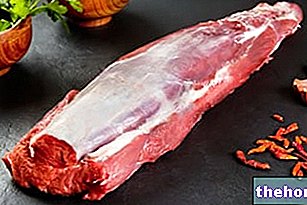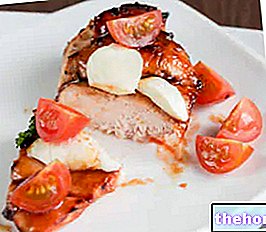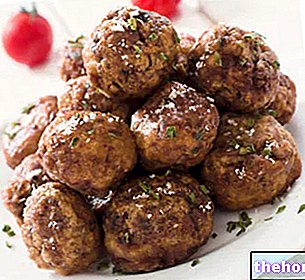Generality
The chicken breast it is a food of animal origin with a high protein content, low in fat and free of carbohydrates; precisely by virtue of these characteristics, chicken breast is one of the most used foods in diets aimed at weight loss, as well as being frequently used in typical bodybuilding diets, both in the mass phase (called bulking), and in the definition phase (called cutting).


Nutritional values (per 100 g of edible portion)
NB. Many values were intentionally omitted in the absence of sufficiently precise data; however, in the description that follows, they will still be mentioned by virtue of their nutritional importance.
Chicken breast also provides a fair amount of vitamins; among these stand out in particular niacin (vit. PP), pyridoxine (vit. B6) and cobalamin (B12); there is also thiamine (vit. B1), riboflavin (vit. B2) and pantothenic acid (B5).
Also noteworthy are the quantities of mineral salts typical of meat, therefore iron (Fe - type heme), phosphorus (P) and zinc (Zn); there is no shortage of small doses of selenium (Se).
The total energy intake of chicken breast corresponds to about 100kcal / 100g (source INRAN), divided into: 93% from proteins and 7% from lipids (1/3 saturated and 2/3 unsaturated, of which about 1/3 monounsaturated and 1/3 polyunsaturated). The amino acid called limiting, since it is less present among the essentials, is tryptophan; as regards the others, in descending order, the most concentrated are: glutamic acid, aspartic acid, lysine, leucine and arginine. Among the fatty acids, C16: 0 (palmitic), C18: 1 (oleic) and C18: 2 (linoleic acid) stand out above all; the ratio between polyunsaturated and saturated fatty acids is equal to 0.9 while cholesterol plays an almost marginal role with its 60mg / 100g.
ATTENTION! In the choice of chicken breast, it is not uncommon that it is also packaged WHOLE and WITH SKIN (to the advantage of the price) compared to the classic WHOLE WITHOUT SKIN or SLICES WITHOUT SKIN; in this case we remind you that, in order to preserve the dietary function, it should be the responsibility of the consumer to REMOVE the skin BEFORE cooking. This procedure is essential as, except for the "grilled"(in which the fat is separated from the food by gravity), the other heat treatments do not allow the" elimination of the lipid component contained in the skin. Eating a chicken breast "with skin", compared to the "analogue" without "skin," involves an increase in the "lipid (triglycerides) supply of about 300%. D" on the other hand, by separating the skin in the dish after cooking, it is possible to preserve "a large part" of the typical leanness of chicken breast, even if, by letting the meat remains in contact with the cooking liquid, the lipid percentage would not however be comparable to that of the skinless food.
NB. With skin, the total cholesterol increase in chicken breast is about 30%.
Role in the diet
Being particularly lean, chicken breast leaves room for alternative lipid sources and - from the point of view of metabolic impact - of better quality; for example, RAW extra virgin olive oil, other cold-pressed and NOT hydrogenated but rich in polyunsaturated fatty acids (grape seed, walnut, kiwi, flax etc.), dried fruit (achenes such as walnuts, almonds, pine nuts etc.) and, why not, also krill oil supplements.
On the other hand, remember that chicken breast is a food with a mainly plastic function and that, being devoid of carbohydrates, fibers, antioxidants, typical vegetable electrolytes (potassium-K, magmesio-Mg) and other functional molecules, it must always leave the right space for the balance and variability of food choices.
Classification and provenance
From a commodity and zoological point of view, chicken breast is a piece of meat deriving from polygamous, oviparous animals that originate precocious offspring, of the type: Vertebrates, class Birds, order Gallinacea, family of the Phasianids, type Gallus, species Domesticus; the most common breeds of chicken in Italy are Livornese and Valdarno, Polverana gigante, Polverara, Ancona, Romagnola, Siciliana, comune.
Which animal is chicken breast made from?
Few really know the classification of chickens, or rather, of the Gallus domesticus; the various nomenclatures such as chicken, hen, rooster, cockerel, capon etc. are always quite vague and confusing, therefore, some definitions will be mentioned below:
- Chick, pullet, pullet, pullet, pullet, pullet: generic term, young chicken (both male and female); slaughtered before 4 months and weighing about 600g depending on the breed
- Chicken: generic term, adult chicken, generally hens no longer oviparous; slaughter from 5 to 12 months, weighing up to 1kg or more depending on the breed
- Pollanca / caponessa: young female of fattened chicken, up to almost 2 kg in weight or more depending on the breed
- Hen: adult female of the chicken species generally oviparous; rooster female, weighing less than 1 kg or more depending on the breed
- Cockerel / cockerel: male young of the chicken species; male of the hen less than 10 months old, about 6
- Rooster: male adult of the chicken species; hen male
- Gallastrone: old male of the chicken species; hen male
- Capon: male young castrated (at 2 months of age and intended for fattening) of the species of chickens; male of the hen; slaughter 6-7 months and weight up to about 2-3kg.
Chickens destined for slaughter, therefore also for the production of chicken breast, can be classified in different ways but, from a health point of view, what matters is the type of farming. Chicken farms are extensive, semi-intensive or intensive; the extensive ones provide a lot of freedom to roam the countryside, the semi-intensive ones DO NOT have the countryside but a medium-sized plot on which to scratch around on the sunniest days, the intensive ones barricade the chickens in the sheds, both "on the ground" and "in battery" .
The health importance of the different types of farming is mainly attributable to the use of drugs (antibiotics, etc.) and to the composition of the meat. An animal that is stationary or segregated within a sealed space is more subjected to infestation and pathogenicity, therefore the use of drugs and disinfestants will certainly be greater; on the other hand, the regulations in force are rather rigid and do not provide for the residue of chemical-pharmacological traces inside the food. Furthermore, the segregated chicken MUST be forced to feed with the feeds given to it which, together with the reduced motor activity, give the meat an unpleasant taste / smell and a less healthy ratio of fatty acids compared to the analogous in extensive or semi-intensive breeding.
The highest quality and safest chicken breast is the one obtained from organic farming as it requires very specific and essential characteristics such as: choice of native breeds, low animal density in the open area dedicated to rocket, use of alternative medicines instead of traditional ones (health characteristic questionable), grazing on grass and ORGANIC FEEDING.
Recipes
As this is not a cookbook, I will leave it to others to accurately describe the most popular recipes based on chicken breast even if, for my part, I think it may be useful to provide a valid track on which to experiment with new ideas in the kitchen. : Chicken Breast with Basil, Grilled Chicken Breast in Norwegian Sauce, Sicilian Chicken Breast, Chicken Breast with Porcini Mushrooms, Chicken Breast with Parmesan, Chicken Breast Brussello, Hawaiian Chicken Breast, Chicken Breast alla valdostana, chicken breast with mixed mushrooms and peas, and chicken breast in Belgian sauce.
Sliced Chicken
Problems with playing the video? Reload the video from youtube.
- Go to the Video Page
- Go to the Video Recipes Section
- Watch the video on youtube
All Video Recipes with Chicken Breast »
Other Foods - Amatriciana Meat Lamb - Lamb Meat Duck - Duck Meat Pork Chop Florentine Steak Boiled Broth Raw Meat Red Meat White Meat Beef Horse Meat Rabbit Meat Pork Meat Vegetable Meat Lean Meat Sheep and Goat Meat Carpaccio Ribs Cotechino Cutlet Snails or land snails Pheasant and Pheasant meat Guinea fowl - Guinea fowl meat Pork fillet Chicken Hamburger Hot Dog Kebab Patè Chicken breast Turkey breast Chicken - Chicken meat Meatballs Porchetta Quail - Quail meat Ragù Sausage Game Zampone OTHER ARTICLES MEAT Categories Food Alcoholic Meat Cereals and derivatives Sweeteners Sweets Offal Fruit Dried fruit Milk and derivatives Legumes Oils and fats Fish and fishery products Salami Spices Vegetables Health recipes Appetizers Bread, Pizza and Brioche First courses Second courses Vegetables and Salads Sweets and Desserts Ice creams and sorbets Syrups, liqueurs and grappas Preparations of Basic ---- In the Kitchen with Leftovers Carnival Recipes Christmas Recipes Diet Recipes Light Recipes Women's Day, Mom, Dad Functional Recipes International Recipes Easter Recipes Recipes for Celiacs Recipes for Diabetics Recipes for Holidays Recipes for Valentine's Day Recipes for Vegetarians Recipes Protein Regional Recipes Vegan Recipes















.jpg)











